
The Solar-Terrestrial Centre of Excellence (STCE) is a collaborative network of the Belgian Institute for Space Aeronomy, the Royal Observatory of Belgium and the Royal Meteorological Institute of Belgium.
 |
Published by the STCE - this issue : 22 May 2015. The Solar-Terrestrial Centre of Excellence (STCE) is a collaborative network of the Belgian Institute for Space Aeronomy, the Royal Observatory of Belgium and the Royal Meteorological Institute of Belgium. |
| Archive of the newsletters | Subscribe to this newsletter by mail |
We need your contribution in support of scientific research!
Don't get confused - this is about seismic activity and not about solar activity.
********
Communiqué de presse 22 mai 2015 09:10 - Séismologie-Gravimétrie/ORB
à 03h52 (heure locale) près de Ramsgate , dans le Kent (Royaume-Uni).
Sa relativement grande profondeur, estimée à 15 km, explique l'absence de dégâts dans la zone épicentrale, ainsi que l'étendue de la zone où le séisme a été ressenti, à plus de 250 km du foyer.
Nous invitons les personnes qui ont ressenti le séisme à nous faire part de leur témoignage sur le formulaire d'enquête en ligne sur http://www.seismologie.be
Ces enquêtes constituent une source précieuse d'information pour l'étude des tremblements de Terre dans nos régions.
Ce séisme s'est produit à 24 km au nord-est du séisme de magnitude 4.3 qui avait frappé Folkestone le 28 avril 2007. Des séismes destructeurs de magnitude estimée à 6 ont également frappé le sud de la Mer du Nord et le Pas-de-Calais en 1382 et 1580.
Le dernier séisme resenti en Belgique avant celui-ci s’est produit à Spa le 13 mai 2015 (magnitude 2.9).
********
Persbericht 22 mei 2015 09:10 - Seismologie-Gravimetrie/KSB
om 03h52 (lokale tijd) nabij Ramsgate, Kent (Verenigd Koninkrijk).
De relatief grote diepte, geschat op 15 km, verklaart de afwezigheid van schade nabij het epicentrum en de grote omvang van het gebied waarin de aardbeving werd gevoeld, tot meer dan 250 km van het epicentrum.
Wij vragen iedereen die de aardbeving heeft gevoeld om hun getuigenis mee te delen via het enquêteformulier dat online beschikbaar is op http://www.seismologie.be
Deze getuigenissen zijn een belangrijke bron van informatie voor het onderzoek naar aardbevingen in onze regio.
Deze aardbeving vond plaats 24 km ten noordoosten van de aardbeving in Folkestone op 28 april 2007, die een magnitude van 4.3 had. In 1382 en 1580 vonden in de zuidelijke Noordzee en Pas-de-Calais verwoestende aardbevingen plaats met een geschatte magnitude van 6.
De laatste aardbeving die in België gevoeld werd vond plaats in Spa op 13 mei 2015 (magnitude 2.9)
********
Press release 22 May 2015 09:10 - Seismology-Gravimetry/ROB
at 03h52 (local time) near Ramsgate, Kent (United Kingdom).
Because of the relative large depth, estimated on 15 km, no damage was seen near the epicentre. But the earth quake was felt in an area, more than 250 km from the epicentre.
If you felt the earth quake, please fill in an online form http://www.seismologie.be
Your input is an important source of information for the research of earth quakes in our region.
This earth quake took place 24 km north east from an earth quake in Folkestone on 28 April 2007 with magnitude 4.3. Also in 1382 and 1580, some devastating earth quakes took place in the Southern part of the North Sea and Pas-de-Calais with an estimated magnitude of 6.
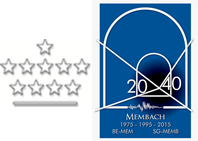
Some very nice prominence and filament eruptions were observed over the last week. In this movie at https://youtu.be/IwbWeXTFfEs, four major events are shown in the combined filters of SDO's (http://sdo.gsfc.nasa.gov/) AIA 304 ("cool"; about 80.000 degrees; red) and AIA 193 ("hot"; about 1.3 million degrees; green). Prominences and filaments usually lay dormant until the surrounding magnetic fields become unstable and eject the material into space. As the plasma traces the untwisting magnetic field lines, it often shows an helical ("corkscrew") motion. More info on these features can be found in e.g. the news items at http://stce.be/news/302/welcome.html , http://stce.be/news/297/welcome.html , and http://stce.be/news/281/welcome.html
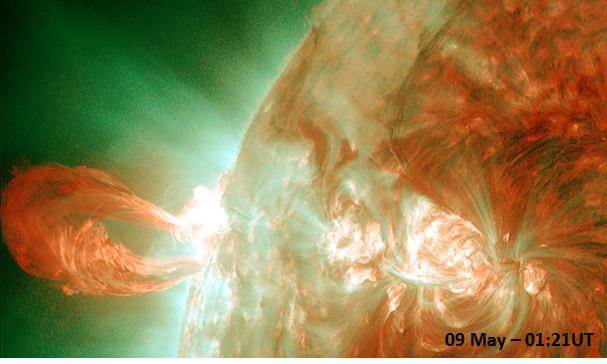
The first eruption took place early on 09 May near the northeast solar limb and was associated with a C7.4 flare peaking at 01:34UT. It was also preceded by a filament eruption in the northeast quadrant, which may have triggered the limb event. The movie clip covers both eruptions and runs from 08 May at 23:30UT till 09 May at 03:30UT. Earth was not affected by the associated coronal mass ejection (CME).
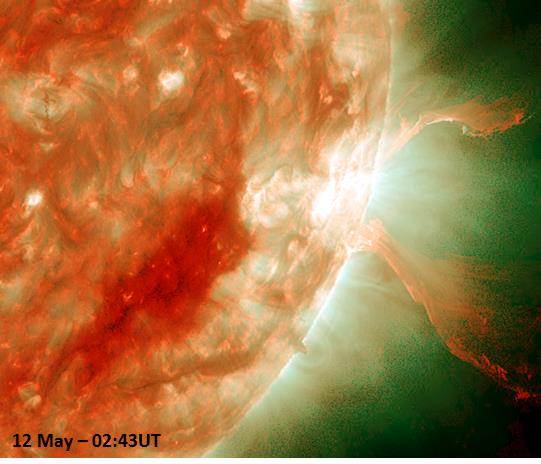
The second eruption took place on 12 May at the west limb and was associated to a C2.6 flare peaking at 03:02UT. The clip covers the event from 01:30UT till 04:30UT. The event enhanced the greater than 10 MeV proton flux (energetic particles), but the flux remained below the alert threshold.
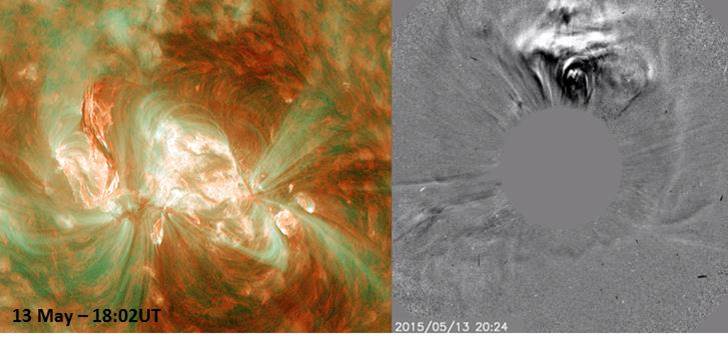
On 13 May, a filament erupted in NOAA 2345, close and to the east ("left") of big active region NOAA 2339. It was associated with the strongest flare of last week, a C9.2 flare peaking at 18:18UT. The bulk of the CME was directed to the north, but a faint full halo CME could be distinguished in difference images made by SOHO's LASCO/C2 coronagraph (http://sohowww.nascom.nasa.gov/). Moving very slowly, it either passed the Earth unnoticed or got mixed with the arrival on 18 May of the high speed stream of a nearby recurrent coronal hole.
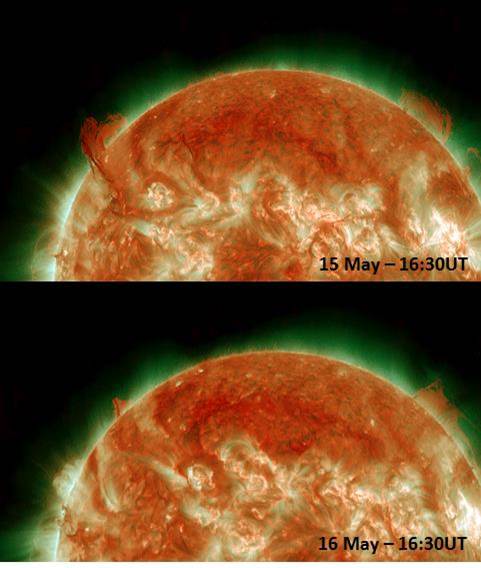
In the night of 15-16 May, a long and dynamic filament impressively erupted near the northeast limb. A few hours later it was followed by the eruption of a nearby, much smaller filament to the west. No obvious flares were associated with these events, and the CMEs had no earth-directed component.
Solar flare activity fluctuated between very low and low during the week.
In order to view the activity of this week in more detail, we suggest to go to the following website from which all the daily (normal and difference) movies can be accessed:
http://proba2.oma.be/ssa
This page also lists the recorded flaring events.
A weekly overview movie can be found here (SWAP week 268).
http://proba2.oma.be/swap/data/mpg/movies/weekly_movies/weekly_movie_2015_05_11.mp4
Details about some of this week's events, can be found further below.
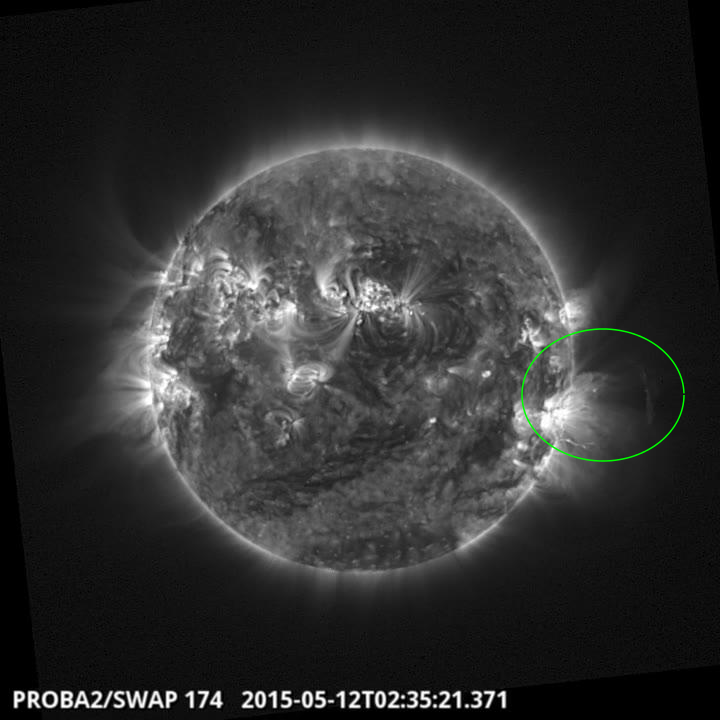
Eruption on the west limb @ 02:35 SWAP image
Find a movie of the event here (SWAP movie)
http://proba2.oma.be/swap/data/mpg/movies/20150512_swap_movie.mp4
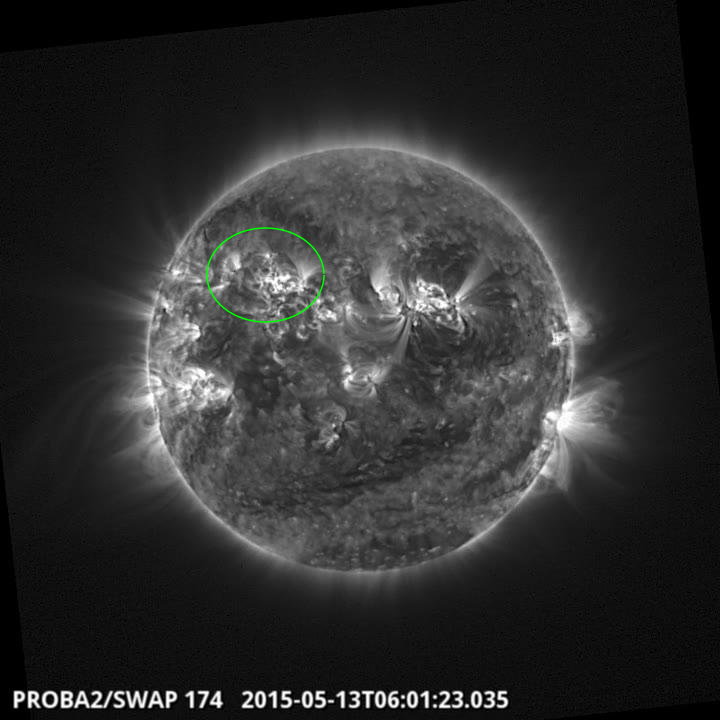
Eruption on the north east quad @ 06:01 SWAP image
Find a movie of the event here (SWAP movie)
http://proba2.oma.be/swap/data/mpg/movies/20150513_swap_movie.mp4
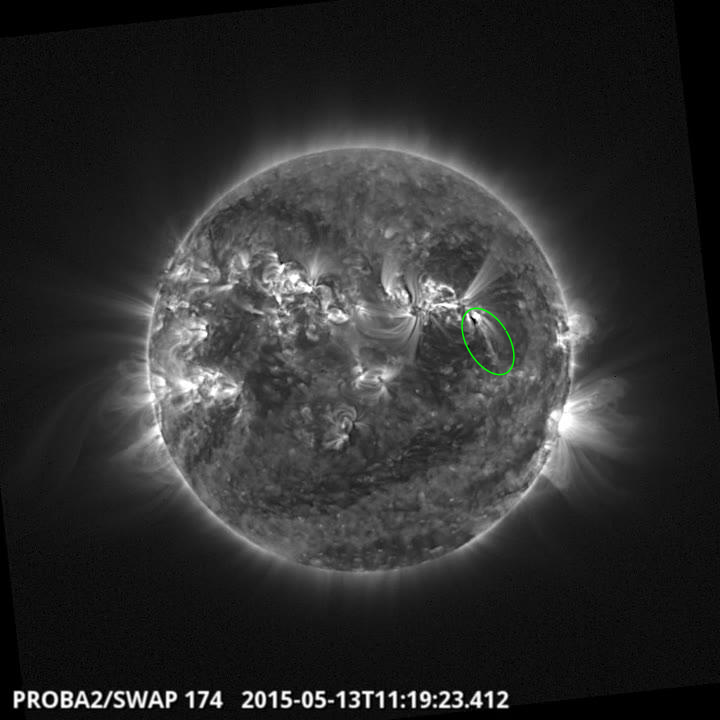
Failed eruption on the north west quad @ 11:19 SWAP image
Find a movie of the event here (SWAP movie)
http://proba2.oma.be/swap/data/mpg/movies/20150511_swap_movie.mp4
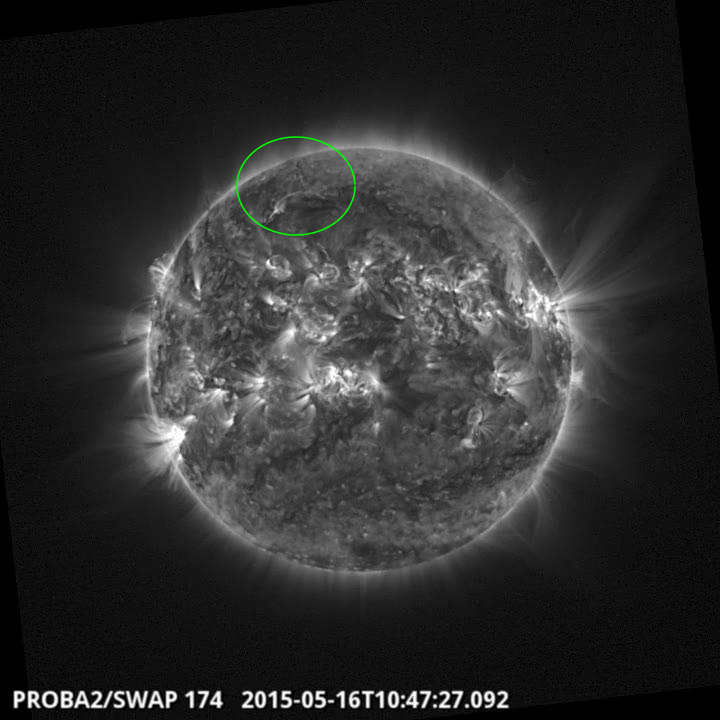
Eruption on the north west quad @ 10:47 SWAP image
Find a movie of the event here (SWAP movie)
http://proba2.oma.be/swap/data/mpg/movies/20150516_swap_movie.mp4
NOAA 2339, the largest and magnetically most complex sunspot region on the visible solar hemisphere, produced 19 of this week's 32 C-class flares. No M-class flares were recorded.
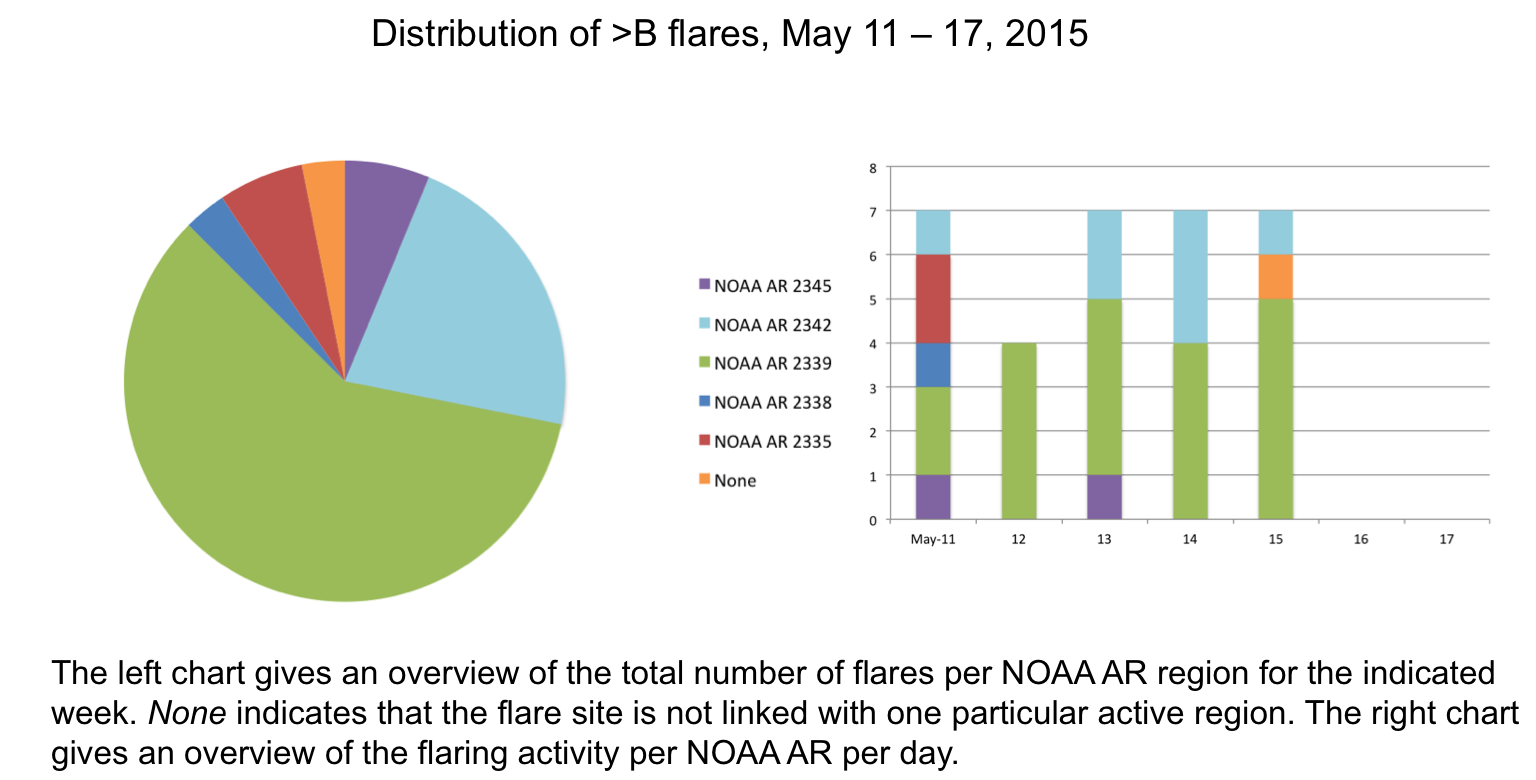
NOAA 2345 produced the strongest flare of the period, a C9.2 flare peaking on 13 May at 18:18UT. It was associated with a faint and slow-moving halo coronal mass ejection (CME), which was still awaited to arrive at Earth on 18 May, but with only unsettled to active geomagnetic disturbances expected.
Numerous filament and prominence eruptions were observed, but none of these had an earth-directed component. A prominence eruption that took place on 12 May (C2 flare peaking at 03:02UT) at the southwest limb was associated with a mild enhancement of the greater than 10 MeV proton flux. A peak of 6 pfu was recorded on 12 May around 07:30UT, staying well below the proton event threshold.
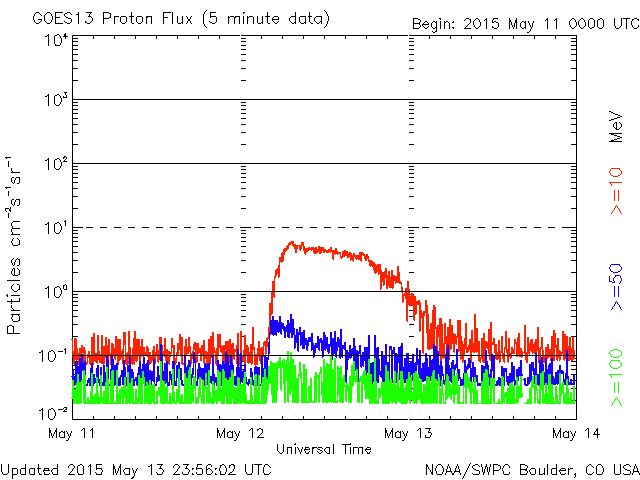
Another noteworthy eruption was that of a long and dynamic filament near the northeast limb late on 15 May, without consequences for the Earth.
On 12 May around 18:00UT, a high speed stream from a negative polarity coronal hole (CH) - green encircled in SDO/AIA 193 image - started to influence the geomagnetic field. Solar wind speed gradually increased to 750 km/s, with Bz-values up to -14 nT recorded.
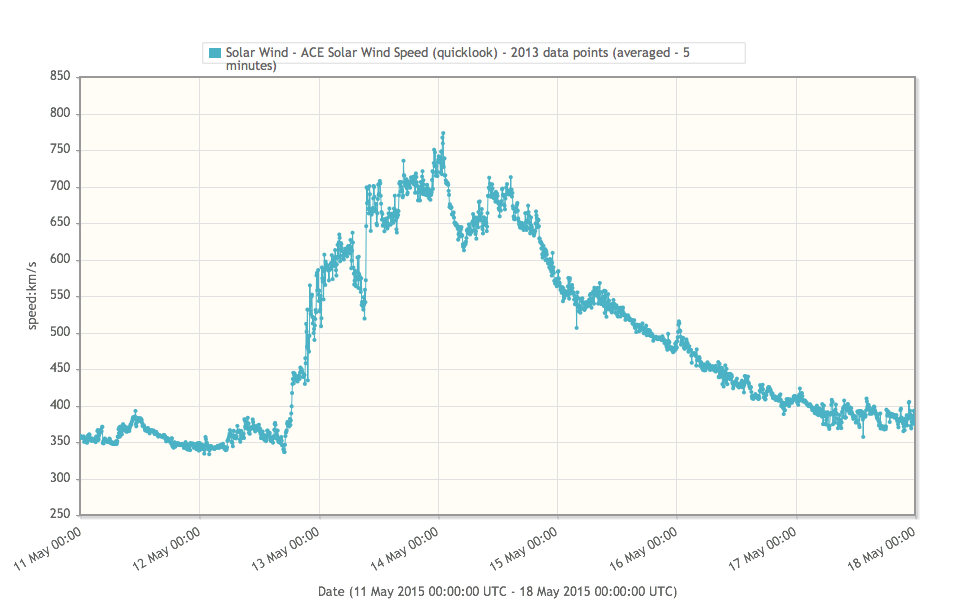
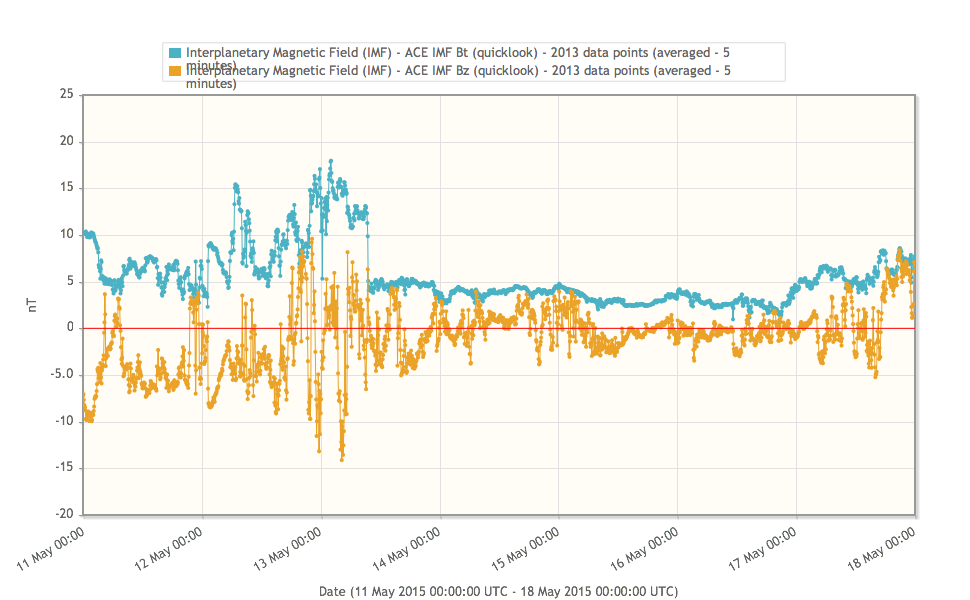
It resulted in active (Dourbes) to moderate storming conditions (Kp=6) on 13 May. From 14 May onwards, only quiet to unsettled geomagnetic conditions were observed. A sector boundary crossing (SBC) occurred on 17 May shortly after 04:00UT, with the direction of the interplanetary magnetic field abruptly changing from towards to away from the Sun.
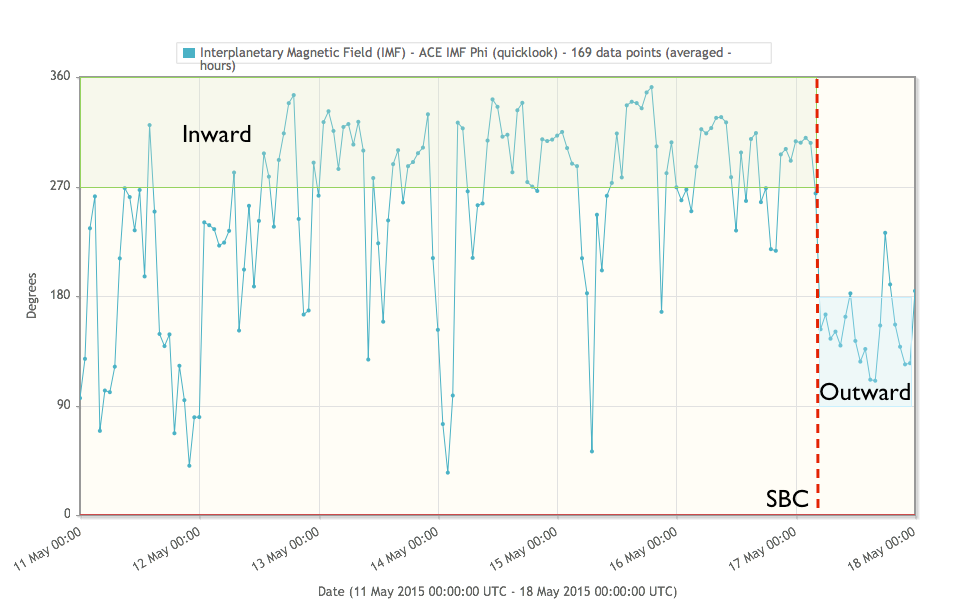
The event had little bearing on the geomagnetic field. The high speed stream from a positive polarity CH that passed the central meridian on 14-15 May was still awaited to arrive at Earth on 18-19 May, with limited geomagnetic impact (active conditions) expected.
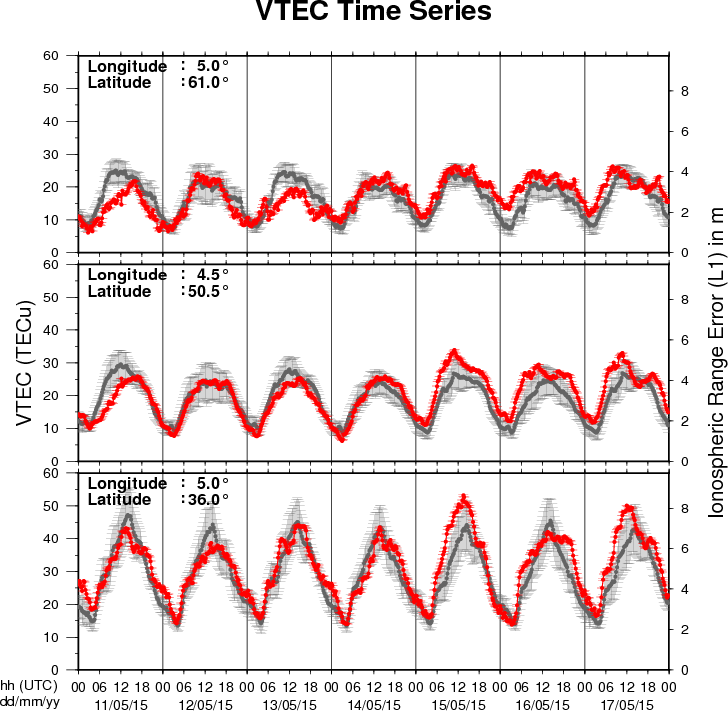
The figure shows the time evolution of the Vertical Total Electron Content (VTEC) (in red) during the last week at three locations:
a) in the northern part of Europe(N61°, 5°E)
b) above Brussels(N50.5°, 4.5°E)
c) in the southern part of Europe(N36°, 5°E)
This figure also shows (in grey) the normal ionospheric behaviour expected based on the median VTEC from the 15 previous days.
The VTEC is expressed in TECu (with TECu=10^16 electrons per square meter) and is directly related to the signal propagation delay due to the ionosphere (in figure: delay on GPS L1 frequency).
The Sun's radiation ionizes the Earth's upper atmosphere, the ionosphere, located from about 60km to 1000km above the Earth's surface.The ionization process in the ionosphere produces ions and free electrons. These electrons perturb the propagation of the GNSS (Global Navigation Satellite System) signals by inducing a so-called ionospheric delay.
See http://stce.be/newsletter/GNSS_final.pdf for some more explanations ; for detailed information, see http://gnss.be/ionosphere_tutorial.php
Start : 2015-05-25 - End : 2015-05-29
25-27 May 2015: BUKS 2015 - MHD waves: Observational aspects
from ground to space - MHD waves: Theory - where are we? - MHD
instabilities
27-28 May 2015: Ruderman Honorary meeting - Theory of linear MHD
waves - MHD waves instabilities - Non-linear waves in plasmas
29 May 2015: Joint BUKS/Ruderman's conferences excursion -
Boat excursion to Szentendre, Visegrad and Esztergom
Website:
http://swat.group.shef.ac.uk/Conferences/BUKS_2015/index.html
Start : 2015-06-01 - End : 2015-06-05
Check the website for more information.
Website:
http://ws-sozopol.stil.bas.bg/
Start : 2015-06-01 - End : 2015-07-24
The Space Weather Summer School at Los Alamos National
Laboratory, established in 2011 under the founding Director Josef
Koller, is dedicated to space weather, space science and
applications. Every year we solicit applications for the Los Alamos
Space Weather Summer School. This summer school is sponsored and
supported by a number or organizations at LANL. This year our top
sponsors include the Los Alamos Institute of Geophysics, Planetary
Physics and Signatures (IGPPS) and the Laboratory Directed Research
and Development Office (LDRD). The summer school brings together
top space science students with internationally recognized
researchers at LANL in an educational and collaborative
atmosphere.
Website:
http://www.swx-school.lanl.gov/
Start : 2015-06-08 - End : 2015-06-12
The RadioSun Workshop and Summer School 2015 is the fourth
international academic seminar supported by the International
Research Staff Exchange Scheme of the Seventh Fromework Programme
of the European Union (FP7-IRSES-295272-RADIOSUN). The aims of this
project are to establish close research interaction and
collaboration between the key EU and non-EU research groups
involved in the research of the Sun in the radio band;
qualitatively advance our knowledge of the physical processes
operating in the solar atmosphere, the basic mechanisms responsible
for its evolution and dynamics and its effect on the Earth; and
provide younger researchers with extensive training in relevant
research techniques and with universal transfer.
Website:
http://www2.warwick.ac.uk/fac/sci/physics/staff/research/davidpascoe/radiosun
Start : 2015-06-09 - End : 2015-06-12
The last five years have seen substantial progress in our
understanding of the solar dynamo, fueled by continuing advances in
observations and modeling. With the launch of NASA's Solar Dynamics
Observatory (SDO) in 2010 came an unprecedented window on the
evolving magnetic topology of the Sun, highlighting its intricate
3D structure and global connectivity. The Helioseismic Magnetic
Imager (HMI) instrument on SDO in particular has provided
potentially transformative yet enigmatic insights into the internal
dynamics of the solar convection zone that underlie the dynamo.
Attempts to detect subsurface convective motions from helioseismic
inversions have yielded only upper limits on the large-scale
convective amplitude, challenging our understanding of global solar
convection. Yet, potential signatures of giant cells have been
detected in photospheric Dopplergrams. Estimates of the meridional
flow from HMI and complementary instruments (SOHO/MDI and GONG)
have been equally tantalizing and enigmatic. Several disparate
techniques, including local and global helioseismic inversions and
correlation tracking of surface features, have yielded evidence of
a multi-cellular meridional flow but they differ on the detailed
flow structure and amplitude. This multi-cellular meridional flow
has potentially profound implications for flux-transport dynamo
models that previously assumed a very different structure with a
single circulation cell per hemisphere.
Website:
https://www2.hao.ucar.edu/Workshop/Solar-Dynamo-Frontiers
Start : 2015-07-05 - End : 2015-07-09
We would like to invite you to submit contributed abstracts to
the parallel session "The science of space weather: progressing our
understanding" at the 2015 UK National Astronomy Meeting from 5-9
July (http://nam2015.org). The abstract-submission deadline is 1
April 2015. Observers, modellers, and theoreticians are all
welcome. We also welcome participation from end users interested in
how the science of space weather is advancing.
The science of space weather: progressing our understanding
The goal of this session is to provide an opportunity to discuss
the scientific research that underpins space weather and how a new
generation of operational space weather measurements could best be
utilised to further progress our understanding. Specific topics are
likely to include 1) gaps in our understanding of space weather and
how to resolve them, 2) new space and ground-based data that are
needed, 3) new science that can be carried out with the operational
space weather measurements being planned today.
This session is motivated by the fact that the UK has a strong
heritage in the science of the coupled Sun-Earth system, from both
an observational and theoretical perspective. This research is
increasingly being applied to the area of space weather monitoring
and forecasting, a topic that is now nationally recognised as an
important natural hazard for the UK (highly ranked in the National
Risk Register) and the subsequent opening of the Met Office Space
Weather Operations Centre in 2014.
Up until now, both the research and the space weather monitoring
and forecasting have utilised mainly data from instrumentation
(both space- and ground-based) designed to answer pertinent
scientific questions, though some operational instruments (e.g. the
X-ray and particle detectors on NOAA's GOES spacecraft) are also
widely exploited for scientific use. However, there is now growing
interest in deploying more instruments, in space and on the ground,
designed to support operational space weather services. Such
operational measurements can facilitate new science, as
demonstrated by the extensive research use of GOES data, but it is
important that the limitations imposed by operational needs are
discussed.
Website: http://nam2015.org/
Start : 2015-07-13 - End : 2015-07-24
The CISM Summer School is intended to give students a
comprehensive immersion in the subject of space weather: what it
is, what it does, and what can be done about it. Space weather is
many things: beautiful when seen through the eyes of a sun-viewing
telescope, fascinating when studied for its alien worlds of
magnetic structures and phenomena, awesome when witnessed as a
solar eruption or auroral storm, and devastating to the users of
services it disrupts. Space weather links the Sun, the Earth, and
the space in between in a branching chain of consequences. Weather
systems on the Sun can spawn interplanetary storms of colossal size
and energy that envelop the whole planet in electrical hurricanes.
Such storms attack high-tech, complex, and expensive technological
systems that provide much of the infrastructure that allows modern
society to function.
Website:
https://www2.hao.ucar.edu/Events/2015-CISM-Summer-School
Start : 2015-07-21 - End : 2015-07-23
The conference will review past and recent achievements, as well
as future challenges in the field of solar coronal loop
physics.
Website:
http://www.damtp.cam.ac.uk/user/astro/cl7/index.html
Start : 2015-07-28 - End : 2015-08-04
Heliophysics is all of the science common to the field of the
Sun-Earth connections. This fast-developing field of research
covers many traditional sub-disciplines of space physics,
astrophysics, and climate studies. The NASA Living with a Star
program, with its focus on the basic science underlying all aspects
of space weather, acts as a catalyst to bring the many research
disciplines together to deepen our understanding of the system of
systems formed by the Sun-Earth connection.
Website:
http://www.heliophysics.ucar.edu/
Start : 2015-07-30 - End : 2015-08-06
The 34th International Cosmic Ray Conference (ICRC) will be held
from July 30 to August 6, 2015, in The Hague, The Netherlands. It
is an important and large conference in the field of Astroparticle
Physics. The ICRC covers: cosmic-ray physics, solar and
heliospheric physics, gamma-ray astronomy, neutrino astronomy, and
dark matter physics.
Website: http://icrc2015.nl
Start : 2015-08-31 - End : 2015-09-04
The purpose of this conference is to discuss the latest
questions and results in solar and stellar physics. Solar and
stellar seismology will be one particular focus but contributions
on all aspects of solar-stellar relations will be welcome. We aim
to establish links and synergies between the day- and night-time
fields of astrophysics.
Website:
http://www.iac.es/congreso/solarnet-3meeting/
Start : 2015-09-02 - End : 2015-09-04
The Workshop will address how the joint exploration of the
corona and inner heliosphere will lead to advances in our
understanding of coronal heating and solar wind acceleration, the
magnetic and plasma structure of the heliosphere, and the
acceleration of energetic particles at shocks and flares. The
workshop will inspire research that will make use of SO and SPP
observations within the context of the NASA Heliophysics
Observatory System and identify key areas for preparatory research.
Synergistic observations from other ground based and space based
assets will also be addressed.
Website:
http://www.solarprobeplus.org/2015/
Start : 2015-09-06 - End : 2015-09-13
The International Workshop and School on solar system plasma
turbulence, intermittency and multifractals (STORM 2015) focus on
the quantitative experimental, theoretical and numerical
investigation of turbulence, intermittency, fractal/multifractal
features, waves and coherent structures interaction, criticality
and non-linear cross-scale coupling. As widely documented by
in-situ satellite measurements and remote or ground-based
observations, turbulence, intermittency and dynamical complexity
are quite ubiquitous processes observed in the dynamics of solar,
planetary and interplanetary plasmas, as well as in the dynamical
evolution of proxies linked to magnetospheric and ionospheric
variability.
Unfolding the spatio-temporal structure of magnetic field and
plasma fluctuations from experimental observations and numerical
simulations provides further insight on the structure of plasma
turbulence and intermittency. On the theoretical side, the
understanding of such complex dynamical behavior cannot be simply
surmised from the basic fluid/kinetic equations, but instead
requires novel theoretical, experimental and data analysis
approaches. The workshop is a forum to present and discuss latest
results in these fields. The purpose of the school is to give to a
young audience of Graduate, Ph.D. students, and postdoc scientists,
which ideally represents the next generation of scholars in the
physics of space plasmas, an overall view of both theoretical and
data analysis tools apt to fully exploit unique and unprecedented
observations that will be provided by future upcoming mission like
Solar Orbiter and Solar Probe Plus.
Website:
http://www.spacescience.ro/conferences/storm2015/
Start : 2015-09-07 - End : 2015-09-11
The meeting will cover various aspects of solar physics and
space weather related processes. The special emphasis will be paid
to progress in data-driven simulations and high-resolution
spectro-polarimetry as powerful diagnostic techniques to unravel
information about magnetic fields in the photosphere and
chromosphere of the Sun.
Website:
http://ssg.group.shef.ac.uk/Conferences/Ukraine_UK_2015/index.html
Start : 2015-09-14 - End : 2015-09-18
The aim of RADECS conferences is to provide an annual European
forum for the presentation and discussion of the latest advances in
the field of radiation effects on electronic and photonic
materials, devices, circuits, sensors, and systems. The scope of
the conference encompasses technological processes and design
techniques for producing radiation tolerant systems for space,
aeronautical or terrestrial applications, as well as relevant
methodologies for their characterization and qualification. The
conference features a technical program, an Industrial Exhibition,
and one day tutorial or "short course" on radiation effects. The
technical program includes oral and poster sessions and round
tables.
Website:
http://www.radecs2015.org/
Start : 2015-09-21 - End : 2015-09-26
A good understanding of solar-terrestrial processes is
fundamental to modelling the influence of solar variability on the
Earth's environment and climate. To capture all the physical
aspects of the solar wind-magnetosphere-ionosphere-atmosphere
interaction, and also the impact of solar variability on climate,
the Sun-Earth system has to be studied as a whole. The main purpose
of this school is to provide graduate, PhD students and also young
post-doc researchers with a global view of the main physical
processes by which solar variability affects the Earth's
environment. In addition, an overview of different data analysis
and methods for describing solar-terrestrial relations will be
given. The school will provide a mix of lectures and activities
requiring students participation.
Website:
http://www.cifs-isss.org/
Start : 2015-10-05 - End : 2015-10-09
This CSPM-2015 scientific meeting will cover various aspects of
solar dynamic and magnetic phenomena which are observed over the
entire electromagnetic spectrum: white-light, Hα, Ca II,
and radio from ground and in a variety of other wavelengths (white
light, UV and EUV, and X-rays) from space. Emphasis will also be
placed on instrumentation, observing techniques, and solar image
processing techniques, as well as theory and modelling through
detailed radiative transfer in increasingly realistic MHD models.
The long-term (cyclic) evolution of solar magnetism and its
consequence for the solar atmosphere, eruptive phenomena, solar
irradiation variations, and space weather, will be in focus. Here,
special attention will be devoted to the long-term observations
made in Coimbra and also to the results of the SPRING / SOLARNET
and SCOSTEP VarSITI studies. In particular, the weak solar activity
during the current solar maximum will be discussed. Finally, since
this meeting is organised around the 90th anniversary of performing
the first spectroheliographic observations in Coimbra, a session
will be specially dedicated to new solar instruments (both
ground-based and space-borne) that will give access to unexplored
solar atmospheric features and dynamic phenomena over the coming
years.
Website:
http://www.mat.uc.pt/~cspm2015/
Start : 2015-10-19 - End : 2015-10-23
The workshop aims to gather experts from the various fields of
remote sensing observations of the inner heliosphere,
including white light, EUV, and radio observation,
together with modellers in order to tackle key outstanding science
and space weather operational issues, establish closer
working relations, and devise the best ways to move the field
forward as a whole. In addition, the science learned from remote
Âsensing observations is critical to improving our
capabilities of space weather forecasting. The workshop
aims to look at ways in which we can more easily and efficiently
share and access the various types of data between individual
groups and subÂcommunities and to officially launch the
IPS Common Data Format v1.0 (IPSCDFv1.0) now in use. It also aims
to allow investigations into ways in which we model the inner
heliosphere looking at the advantages and disadvantages of the
available modelling, updates on present and future
remoteÂsensing capabilities, and investigating further
the ways in which these data sets all complement each other and are
necessary to gain knowledge and understanding of the fundamental
physical processes that occur within the inner heliosphere. These
are critical processes that are key to both Heliophysics science as
well as to spaceÂweather operations and forecasting.
Website:
http://www.sciesmex.unam.mx/workshop2015/
Start : 2015-10-26 - End : 2015-10-29
In the tradition of the series of »Potsdam
Thinkshops«, we invite instrument specialists,
observers, modellers, and theorists to exchange ideas, to stimulate
discussion, to initiate future collaborations among participants,
and to attract new users of instruments by showcasing the
capabilities. The aim is to make progress towards a comprehensive
description of solar eruptive events effectively aggregating their
global properties as well as their highly dynamic fine
structure.
Website:
https://thinkshop.aip.de/12/cms/
Start : 2015-10-26 - End : 2015-10-30
The workshop is to improve the scientific understanding of the
origin and propagation of solar transients, and develop the
prediction capacity of these transients' arrival and potential
impact on the Earth. The workshop engages coordinated international
activities in observation, theory and modeling, and involves
scientists in both developed and developing countries, and provides
an online platform for educational opportunities for students.
Website:
http://cintli.geofisica.unam.mx/congreso/
Start : 2015-11-10 - End : 2015-11-13
Observations of the Sun and Earth from space have revolutionized
our view and understanding about impacts of solar variability and
anthropogenic forcing on Earth climate. For more than three solar
cycles since 1978, the total and spectral solar irradiance (TSI and
SSI) and global terrestrial atmosphere/surface have been observed
continuously, enabling unprecedented quality data for Sun-climate
studies. The primary objective of this symposium is to convene
climate scientists, solar physicists, and experimentalists together
for a better understanding how Earth climate system changes and
responds to solar variability.
Website:
http://lasp.colorado.edu/home/sorce/news-events/meetings/2015-sun-climate-symposium/
Start : 2015-11-23 - End : 2015-11-27
The European Space Weather Week (ESWW) is the European forum for
Space Weather users, forecasters, scientists and the involved
industries, as proven by the high attendance to the ESWW 11 in
November 2014.
The ESWW 12 will be held in Belgium in November, 23-27, 2015 and
its organisation has already started and is benefiting from the
experience and inputs from the past editions.
Website: http://stce.be/esww12/
Start : 2016-05-22 - End : 2016-05-27
Electric currents are fundamental to the structure and dynamics
of space plasmas, including our own near-Earth space environment
(also called "geospace"). This recognition is one of the great
achievements in space research, going back to the beginning of the
last century. With the current multi-spacecraft missions, such as
Cluster, THEMIS and Swarm, we have unprecedented opportunities to
unravel many of the intriguing puzzles about electric currents.
The conference will provide a forum in which various space
science communities can come together to discuss recent
achievements of observational, theoretical, and modelling studies.
The emphasis will be on cross-disciplinary science sessions.
Website:
http://chapman.agu.org/spacecurrents/general-informationabout-conference/
Start : 2016-07-30 - End : 2016-08-07
The 41st COSPAR Scientific Assembly will be held in Istanbul,
Turkey from 30 July - 7 August 2016. This Assembly is open to all
bona fide scientists.
Website:
https://www.cospar-assembly.org/
Start : 2016-10-09 - End : 2016-10-13
The scientific goal of this symposium is to discuss recent
results on the processes shaping the structure of the solar
atmosphere and driving plasma eruptions and explosive events.
Activity of the solar atmosphere entails numerous multi-scale
processes. State-of-the-art solar instrumentation is revealing the
dynamics of the Sun with unprecedented temporal and spatial
resolutions. Together with advanced numerical simulations these
investigations are making new steps in our understanding of the
complex dynamical structure of the solar atmosphere.
Major unsolved problems of astrophysics such as how the solar
corona is heated and how the solar wind and heliosphere are powered
have their roots in the origin of small-scale magnetic fields
constituting the Sun's 'magnetic carpet' in the
photosphere and appearing as 'magnetic canopy' in the
chromosphere.
Website:
http://www.iau.org/science/meetings/future/symposia/1160/